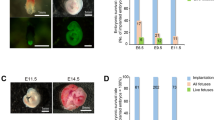Abstract
Data have been obtained indicating that cortisone-induced cleft palate in the mouse is linked to theH-2 a complex. Cortisone (2.5 mg) was administered to pregnant females on days 11 through 14 of pregnancy. On day 17 of pregnancy, the fetuses were inspected for cleft palates. Sham experiments were done by injecting sterile saline instead of cortisone. The inbred strains, A/J and C57BL/6, and the congenic strains C57BL/10ScSn and B10.A were tested for susceptibility to cleft palate. The clefting frequency was also observed in hybrids of the congenic strains. The A/J and B10.A strains showed a characteristic high susceptibility to cleft palate (i.e., 99% and 81% incidence of cleft palate, respectively) after teratogenic treatment. The C57BL/6 and C57BL/ 10ScSn demonstrated a significant resistance to the teratogen (i.e., 25% and 21 % incidence of clefting, respectively). The teratogenic treatment of congenic hybrids indicated that maternal influences significantly affected the incidence of cleft palate formation. The maternal influence appeared to depend upon the specificH-2 haplotype of the mother.
Similar content being viewed by others
References
Bennett, D., Boyse, E.A., and Old, L.J.: Cell surface immunogenetics in the study of morphogenesis. In: L.G. Silvestri (ed.):Cell Interactions. Proceedings of the Third Lepetit Colloqium; pp. 247–263, American Elsevier Publishing Co., Inc., New York, 1972
Bonner, J.: Method for evaluating intrauterine versus genetic influences on craniofacial anomalies.J. Dent. Res. 53:1313–1316, 1974
Burdi, A., Beingold, M., Larsson, K.S., Leck, I., Zimmerman, E.F., and Fraser, F.C.: Etiology and pathogenesis of congenital cleft lip and cleft palate. An NIDR state of the art report.Teratology 6:225–270, 1972
Chabora, A.J. and Horowitz, S.L.: Cleft lip and cleft palate: one genetic system.Oral Surg. 38:181–186, 1974
Fraser, F.C. and Fainstat, T.D.: Production of congenital defects in the offspring of pregnant mice treated with cortisone.Pediatrics 8: 527–533, 1951
Green, E.L.: Breeding systems. In E.L. Green (ed.):Biology of the Laboratory Mouse; pp. 11–12, McGraw-Hill, New York 1966
Gregorová, S. and Iványi, P.: H-2 associated genetic differences in androgen-dependent traits. The effect of testosterone injections.Folia Biol. (Praha) 19:337, 1973
Iványi, P., Gregorová, S., and Micková, M.: Genetic differences in thymus, lymph node, testes and vesicular gland weights among inbred mouse strains. Association with the major histocompatibility (H-2) system.Folia Fiol. (Praha) 18:8, 1972a
Iványi, P., Hampl, R., Stárka, L., and Micková, M.: Genetic association between H-2 gene and testosterone metabolism in mice.Nature New Biol. 238:280–281, 1972b
Jirsáková, A. and Valhová, I.: Genetical aspects in experimental induction of the cleft palate by cortisone in inbred strains of mice.Acta Chir. Plast. 12:10–21, 1970
Kalter, H.: Interplay of intrinsic and extrinsic factors.In J.G. Wilson and J. Warkany (eds.):Teratology: Principles and Techniques; pp. 57–64, University of Chicago Press, Chicago, 1965
Pruzansky, S., Clifford, E., Converse, J.M., Johnston, M.C., Langman, J., Lis, E.F., Slavkin, H.C., and Warkany, J.: Report of the ad hoc advisory committee on program strategies for research on craniofacial anomalies, July 1973. National Institute of Dental Research, Bethesda, Md. 20014
Rychlíková, M., and Iványi, P.: DNA synthesis in lymph node cells of mice: differences associated with the H-2 system.Folia Biol. (Praha) 20: 68–71, 1974
Slavkin, H.C., Trump, G.N., Mansour, V., Matosian, P., and Mino, W.G.: Localization of H-2 histocompatibility alloantigens on mouse embryonic tooth epithelial and mesenchymal cell surfaces.J. Cell Biol. 60: 795–801, 1974
Snell, G.D., Cherry, M., and Démant, P.:H-2: Its structure and similarity to HL-A.Transplant. Rev. 15:3–25, 1973
Walker, B.E. and Fraser, F.C.: The embryology of cortisone-induced cleft palate.J. Embryol. Exp. Morphol. 5:201–209, 1957
Author information
Authors and Affiliations
Rights and permissions
About this article
Cite this article
Bonner, J.J., Slavkin, H.C. Cleft palate susceptibility linked to histocompatibility-2 (H-2) in the mouse. Immunogenetics 2, 213–218 (1975). https://doi.org/10.1007/BF01572289
Received:
Issue Date:
DOI: https://doi.org/10.1007/BF01572289




